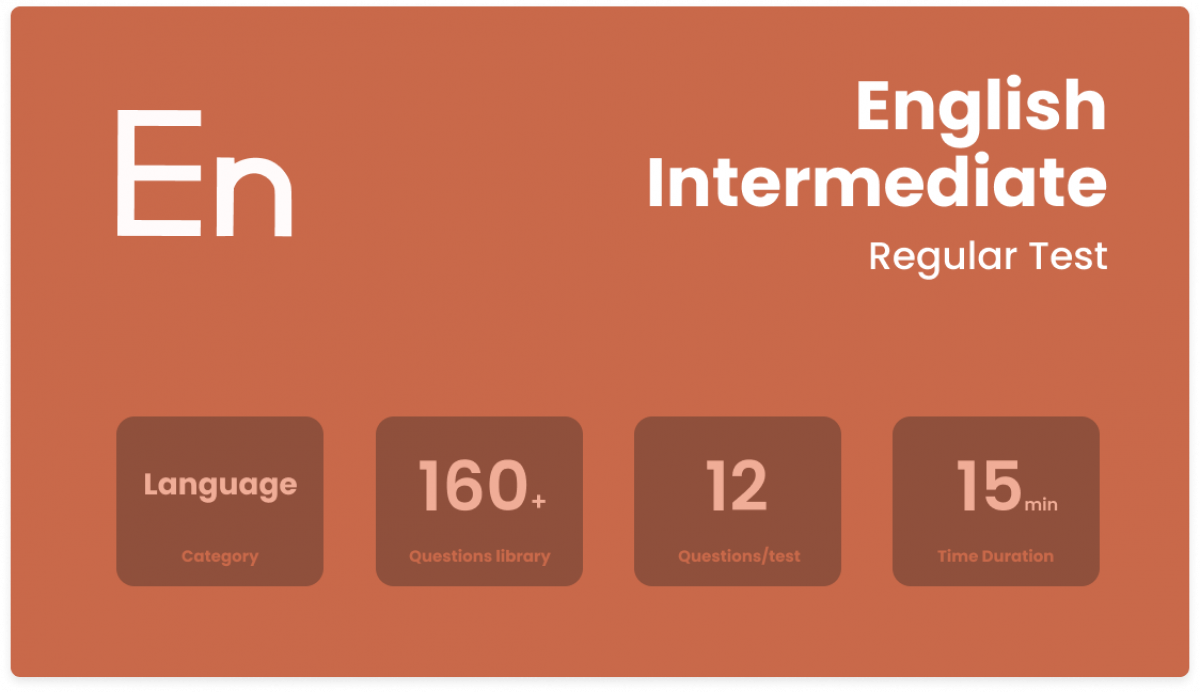Help Desk
English Intermediate

About
The English-Intermediate test assesses the candidate’s understanding of the English language at the intermediate to higher levels. This test specifically assesses the candidate's ability to understand and interpret prose, structure ideas, find the main idea, understand specifics and the “big picture” of prose, make logical inferences, find errors in grammatical structure, and optimize for better grammatical syntax, word usage, and vocabulary.
Candidates with higher percentile scores tend to be better at understanding and possibly, usage of the English language.
What does this test measure?
- Understanding of the English Language
- Understand and Interpret prose
- Intermediate Vocabulary and Vocabulary in Context
- Grammatical Syntax
Where to use this test?
This is also a sector agnostic test and can be used wherever you require English skills from candidates. But please don't use this test along with the critical thinking section as it makes the "English intermediate" test redundant.
Content
- Reading comprehension passages
- Grammatical syntax correction questions
- Vocabulary – word-in-sentence type questions
Example 1 - Reading Comprehension
The study of life on Earth ultimately involves the study of the molecules of which living organisms are composed. How does photosynthesis convert the energy of sunlight into the energy of sugar molecules? What is the structure of the cell membrane, and how does it function in controlling the movement of materials into and out of the cell? How do the muscles contract? How do the nerve cells in your brain communicate with one another? What causes cancer? To understand the answers to these questions, you must first learn about energy and matter, the properties of atoms, and how atoms interact with one another to form molecules.
The idea that photosynthesis is essential to life has been fundamental to our understanding of Earth’s biosystems. If the sun were to go out, we assumed, life would soon follow, yet in the 1970s, scientists discovered organisms rely on bacteria that harvest energy not from light but from the chemical bonds in sulfides and other molecules in a proven way called chemosynthesis. Other more complex organisms then incorporate the living bacteria into their tissues. Such relationships mirror the myriad complex relationships we see in the photosynthetic food chain, in which bacteria are incorporated into organisms to provide benefits such as breaking down or synthesizing chemicals that the organisms' own tissues cannot.
1) Which question posed in paragraph 1 most directly concerns the author of paragraph 2?
A) how does photosynthesis . . . molecules?”
B) “What is the structure . . . the cell?”
C) “How do the nerve . . . one another?”
D) “What causes cancer?”
Answer - (A)
2) Both paragraphs are primarily concerned with
A) the complexity of structures in living tissue
B) the origin and evolution of life on Earth
C) the chemical processes that sustain life
D) the symbiotic relationship among species
Answer - (C)
3) The questions in sentences 2–6 represent
B) sources of frustration to biologists
C) areas of productive inquiry
D) inspirations for recent innovations
Answer - (C)
Example 2 - Grammatical Syntax
1) Researchers has been investigating how animal species have come to use coloring as a means of protecting themselves. One study has shown that certain animals have glands that release special hormones, resulting in the change of skin or fur color.
A. NO CHANGE
B. investigated
C. were investigating
D. investigate
Answer - (C)
2) Although secret identities and elaborate disguises are typically associated with the world of spies and villains, it has other uses. For six years, Ruth Reichl the restaurant critic for New York Times, used aliases and costumes as a regular part of her job.
A. NO CHANGE
B. Reichl, the restaurant critic, for the New York Times,
C. Reichl, the restaurant critic for the New York Times,
D. Reichl the restaurant critic for the New York Times
Answer – (C)
Example 3 - Vocabulary
1) The ozone layer may still act like a protective blanket, but scientists continue to worry about the sun’s other ___________ lethal effects.
A) potentially
B) equivalently
C) indifferently
D) approximately
E) abruptly
Answer – (A)
2) Unfortunately, few children behave in such a ____________ manner towards the elderly and infirm.
A) ridiculous
B) considerate
C) restricted
D) fragile
E) progressive
Answer – (B)
Supported by:
